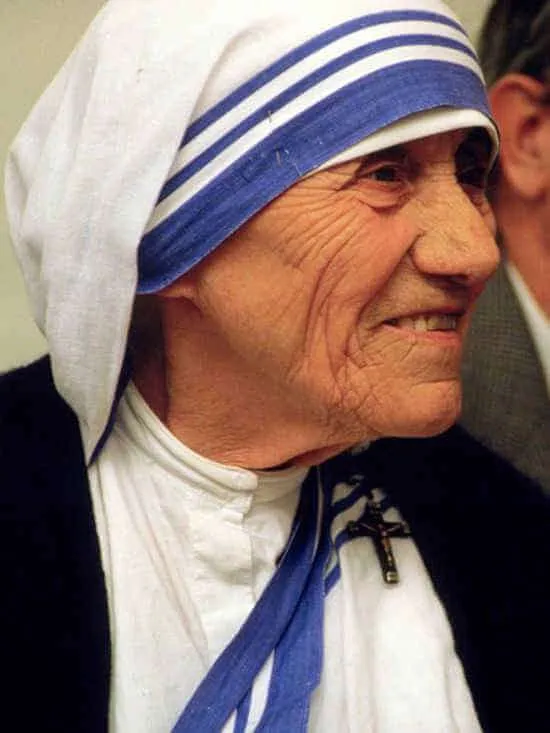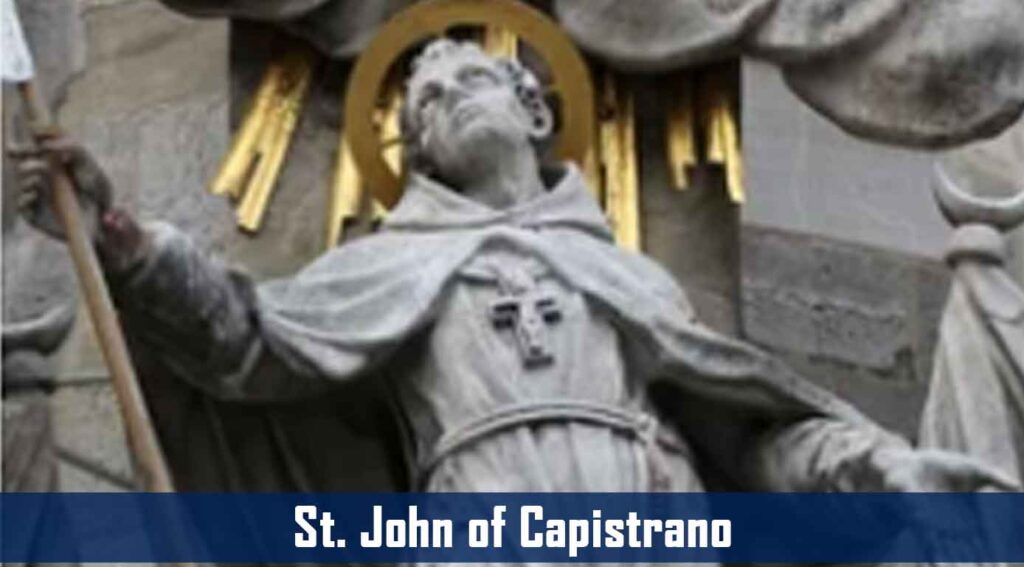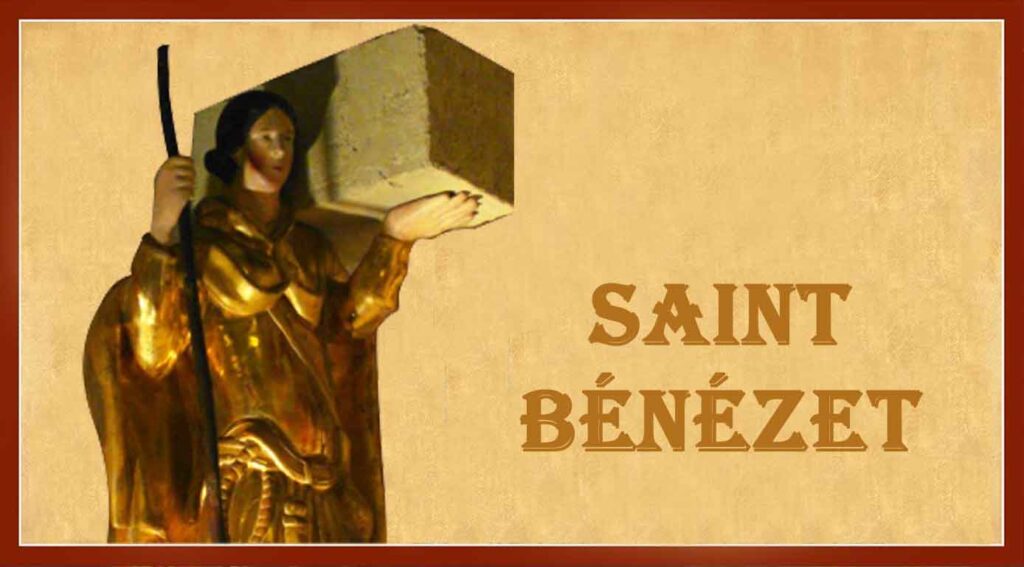1910–1997; Patron Saint of Calcutta and the Missionaries of Charity; Canonized by Pope Francis on September 4, 2016
Saint Mother Teresa of Calcutta was born Anjezë Gonxhe Bojaxhiu in Skopje, present-day North Macedonia. At the time of her birth, Anjezë’s hometown was part of the vast, predominantly Muslim Ottoman Empire, which spanned three continents. Today, Skopje is considered the political, cultural, economic, and academic center of North Macedonia, with a rich and ancient history dating back to Roman times. Anjezë was the youngest of five children, two of whom died in infancy. Her parents were devout Catholics who raised her in the faith. Her baptismal name was Gonxhe, meaning “rosebud” or “little flower” in Albanian, and it was by this endearing name that she was often called as a child.
When Gonxhe was eight, her father died suddenly, plunging the family into financial difficulties. At the age of twelve, Gonxhe felt a divine calling to serve the poor. Upon turning eighteen, she left home, never to see her mother or sister again, and entered the Institute of the Blessed Virgin Mary in Ireland, known as the Loreto Nuns, with the desire to serve in India. After learning English in Ireland, she moved to India in 1929 and became a novice at the Loreto house in Darjeeling. In 1931, she made her first profession of vows, taking the name Teresa, after Saint Thérèse of Lisieux. She was assigned to the Loreto Entally community in Calcutta, where she taught at Saint Mary’s Bengali Medium School for girls. She made her final vows in 1937, upon which she assumed the name “Mother Teresa,” as was customary among the Loreto Sisters. She spent the following eleven years in Calcutta with the Loreto Sisters, totaling twenty years in all.
On September 10, 1946, when Mother Teresa was thirty-six, she was traveling by train roughly 400 miles from Calcutta to the mother house in Darjeeling for an annual retreat and time of rest. It was during this trip that something mystical occurred. Although she kept the details of that experience private, she later recounted, “I heard the call to give up all and to follow Him into the slums—to serve Him in the poorest of the poor…I knew it was His will and that I had to follow Him. There was no doubt that it was going to be His work.” How she heard this call remains a mystery, but it was so compelling and convincing that she spent the subsequent two years discerning this call, consulting her spiritual director, and ultimately obtaining permission from her religious superiors. Mother Teresa had received a “call within a call” to quench the thirst of Jesus by serving the poorest of the poor. September 10 would henceforth be celebrated as “Inspiration Day,” the day on which she believed God founded what would become the Missionaries of Charity. Over the next year and a half, Mother Teresa repeatedly heard the “Voice” speak to her, guiding her and calling her to trust, surrender, and love. “Come, come, carry Me into the holes of the poor. Come, be my light.”
The theme of Jesus’ thirst on the Cross would permeate everything Mother Teresa did from that time forward. It was the central mission she had received, the purpose of her life, and the reason God wanted her to found the Missionaries of Charity. Jesus, as the Infinite God, had an infinite thirst. With no end to the depth of Jesus’ thirst, there was no end to the depth of love she was called to give to Him by loving the poorest of the poor and all of God’s children. Not only was Mother Teresa called to quench Christ’s thirst in those whom she served, she was also called to encounter Jesus in them. They were Jesus, hidden in the distressing disguise of the poor.
After her retreat, Mother Teresa spoke to her spiritual director, Father Van Exem, about her calling. Although he knew this was from God, he decided to test the call and forbade her to talk about it or even to think about it. After four months, however, Father Exem felt the time was right and gave her permission to write to the archbishop. She wrote to him, sharing what Jesus spoke to her, “I want Indian nuns, Victims of My love…I want free nuns covered with my poverty of the Cross…I want obedient nuns covered with My obedience of the Cross…I want full of love nuns covered with the charity of the Cross. Will you refuse to do this for Me?”
During the four months prior to sending this letter, the other sisters noticed that Mother Teresa spent an unusually long time in the confessional with Father Exem. Suspecting an unhealthy attachment between them, her superiors transferred her to another convent. Furthermore, the archbishop had concerns about her call and instructed her to wait and pray. He informed her he was traveling to Rome and would not return for several months, at which time he would reconsider her request. After more back-and-forth letters and conversations with Father Exem, Father Exem presented Mother Teresa with a final test. He told her that she was to “drop the whole thing for eternity,” never to bring it up again unless he or the archbishop initiated the conversation. Mother Teresa obeyed, and some months later Father Exem raised the topic again. He and the archbishop continued to test her and even challenge her. She responded from her heart, sharing everything the “Voice” had said to her. Finally, on January 6, 1948, the archbishop gave her permission to proceed. He later wrote to the Loreto superior, “I am deeply convinced that by withholding my consent, I would hamper the realization, through her, of the will of God.” After receiving permission from the Loreto Superior, as well as from the Holy See, Mother Teresa began her new mission on August 17, 1948, almost two years after her “Inspiration Day.”
On December 21, 1948, after completing medical training, Mother Teresa began her life as a Missionary of Charity in the slums of Calcutta. Calcutta had been heavily affected by World War II, famine, and ongoing riots. Countless people were homeless, poor, uneducated, and suffering intensely. After securing a place to live, Mother Teresa began caring for the poor. She dressed their wounds, showed compassion for the suffering, listened to their stories, provided them with food, and treated them as if they were Jesus. This was a novel approach in India where poverty was sometimes viewed as a result of bad karma. In March 1949, one of her former students joined her in the work. By the following year, her companions numbered twelve. On October 7, 1950, with the approval of the Holy See, the Missionaries of Charity were formally established in the Archdiocese of Calcutta. In addition to the usual three vows, the Missionaries of Charity took a fourth vow “to devote themselves with abnegation to the care of the poor and needy who, crushed by want and destitution, live in conditions unworthy of human dignity.”
By the early 1960s, the number of sisters continued to grow, and houses were established in various parts of India. Shortly thereafter, the Missionaries expanded their reach to Venezuela, Rome, and Tanzania. In 1963, the Missionaries of Charity Brothers was established. A contemplative branch of the sisters was founded in 1976, followed by the Contemplative Brothers in 1979, and the Missionaries of Charity Fathers in 1984. In 1962, Mother Teresa received the Padma Shri Award from the Republic of India, and in 1979, she was honored with the Nobel Peace Prize, which she accepted “in the name of the hungry, of the naked, of the homeless, of the crippled, of the blind, of the leprous, of all those people who feel unwanted, unloved, uncared, thrown away of the society, people who have become a burden to the society, and are ashamed by everybody.” After that, she was sought out and welcomed by kings, dictators, presidents, prime ministers, and religious leaders and enjoyed an open door from the pope any time she was in Rome. Her influence on an international level was profound, yet she remained deeply humble and devoted to her central mission of love. By the 1990s, houses had been set up on every continent, including nearly every communist country. By the time of her death in 1997, the Missionaries of Charity numbered about 4,000, across 610 foundations in 123 countries. Two years after her death, Pope John Paul II opened her cause for canonization. He beatified her in 2003, and she was canonized by Pope Francis in 2016.
Saint Mother Teresa of Calcutta was one of the greatest saints in all of history. After her death, those closest to her shared many of her private letters that tell an incredible story. From the time she began her work with the poor and suffering, she started to experience an inner darkness, a complete loss of the sense of God’s presence. This interior darkness mirrors the spiritual writings of the greatest mystics, such as Saints John of the Cross and Teresa of Ávila. God stripped her of every interior consolation so that her charity would be absolutely pure and devoid of all selfish motivation, resulting in pure selfless giving, fueled by unshakable faith, and driven by divine hope. She was truly a mystic in the deepest sense, an icon of the satiation of Christ’s Thirst.
Source: https://mycatholic.life/saints/saints-of-the-liturgical-year/september-5-saint-mother-teresa-calcutta/








